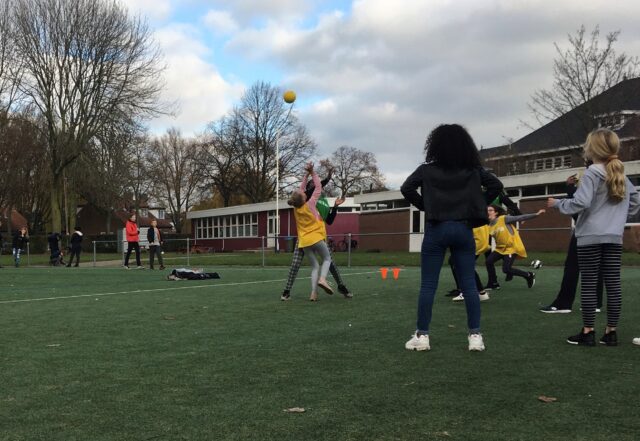Sports and youth work during COVID-19: small groups, large spaces and youth leaders
Year of production: 2020
Image: Yoga in the park during COVID-19, Youth Ambassadors 's Hertogenbosch, Original photo
‘How can we be more innovative in the future?’ Sheila asks herself. After the sudden arrival of COVID-19, youth workers and community sports coaches around Europe (Including youth workers and community sports coaches from Belgium, Denmark, the Netherlands, the UK and the USA) attempted to continue doing their work online. As Sheila, project leader for youth participation in ‘s-Hertogenbosch, and her colleagues did: engaging and supporting ‘their youth’ virtually, was as good as it got. However, just doing the same thing, only online, falls short. ‘Online often is too superficial’, less fun, less motivating and less effective, as young people like to say (Focus group discussion with twelve Youth Ambassadors (aged 16-26 years)). Although Sheila’s team can proudly note that no youths dropped out of the programmes last spring, the biggest challenge facing them this autumn is how to be better.
Below you will find practical tips and tools for youth workers and community sports coaches on how to be more creative, engage new participants or reach out to isolated young people. We need to figure out how to do that, now that the pandemic seems to be stretching itself into a longer period than we ever expected it would.
Find out what young people want and need
First of all, ‘we need to find a way to get to know what it is that young people want and need right now’, advises Deborah Moore (Webinar of Deborah Moore, Youth Work Learning Lab, and the Youth Studies and Youth Development Leadership Departments at the University of Minnesota – School of Social Work (August 2020)). Talking to twelve Youth Ambassadors from ‘s-Hertogenbosch, capital of the Dutch region that was hit hardest by the coronavirus, they first mention fear of or caution concerning the disease itself. ‘All of the young people knew someone who had COVID-19’, as one of the youth workers mentions. For young people themselves, the consequences of the regulations apply more heavily: loss of jobs and failure to find an internship, which in turn causes study delays. ‘Young people are most negatively affected by COVID-19 when it comes to their mental health’(Health Foundation, August 2020).
The Youth Ambassadors used online meetings to design and organise activities for young people around town. They were able to do so because they already knew each other before corona broke out. However, they unanimously agree that meeting new people doesn’t work online. In their new studies or work, Youth Ambassadors have realised that you first need to build relationships, before you can work together. Casper reveals: ‘I lost my job, due to corona. Luckily, I recently found a new one; however it is taking much longer to get to know my new colleagues’. Still, getting to know people is what young people need in order to be able to grow, personally and professionally, socially and emotionally, and to ‘build the foundations for a healthy adulthood’(Health Foundation, August 2020).
Moreover, many online alternatives set up quickly by schools, youth work and community sports, are seen to be superficial. ‘Online, we’re given the recipes, but not the ingredients’, Lucas explains. Whereas, he was looking for time to experiment and tools to learn – for instance about fundraising, organising and networking – the opposite was true. For instance, projects during COVID were expected to yield rapid results, as required by the sponsors. Altogether, it leaves less room for experimenting, failing and learning.

Involve young people in decision-making
Sheila explains how they involved young people when COVID-19 broke out. She works with a team of youth workers and community sports coaches (The town of ‘s-Hertogenbosch Is unique in the Netherlands by combining youth work and community sports in one programme for youth, called PowerUp073, since 2016. Youth participation according to the participation ladder is core to their work) on youth participation – from experiencing and consulting, towards co-designing and leading activities. Part of her work is training and supporting young people when it comes to designing and leading their own athletic or artistic activities. Her team sent out a survey to young people though secondary schools, asking them three simple questions:
- What activities do you want to see this summer in your neighbourhood?
- Would you like to help in organising those activities?
- What is your phone number?
A total of 150 suggestions were received! Ten young people indicated that they wanted to help as well. A selection of ideas was placed on social media as a poll for all young people to vote on. And the best activities were selected and organised.
Be more creative in designing ‘corona’-activities
A great tool to make sure that you are providing a mix of online and offline activities, as well as reaching isolated youth, is to come up with activities for each of the five ways of connecting with youth: in person, online, phone, home visits and e-mail (Webinar of Deborah Moore (August 2020)). ‘These times require that we be creative. And everyone is trying to be creative, but it should be even more so!’ explains Youth Ambassador Noor.
Brainstorm in a small group concerning activities in the time of COVID-regulations for each of the five methods listed above. Activities should match the needs of young people and your role as a youth worker or coach.
In person
For example, come together in small groups to engage in outdoor sports or fun games, like a hunt through the neighbourhood, yoga in the park, or a water battle.
Online
For example, fitness challenges, sport tricks or kick-boxing classes. As well as other healthy and fun activities, such as making smoothies or baking together online. Coaches and youth workers (Author’s own survey among two community sports coaches and two policy makers in youth participation) mentioned using Instagram, Snapchat, Houseparty and PlayStation for these online sessions.
Phone
Before you start organising activities, you want to know what young people want and need! Pick up the phone (or use WhatsApp) and ask them.
Home visits
Go where the young people are: Ring doorbells, visit young people’s meeting places or go where everyone needs to be now and then, like the local grocery store. Chat for 10 minutes or do a fun activity. Or bring volunteers cookies or something interesting to read.
E-mail
For example, send a motivational note, an inspirational video of interest or an invitation to an upcoming event.
Sample activities
Knowing that COVID-19 regulations affect the physical and mental health of young people through inactivity, community sports can be a great tool to help young people be active in small groups, close to home. Sheila adds: ‘When we were allowed to start working in small groups again, sports activities were the easiest to promote among young people, because they are fun, visible and bring people together’. What’s more, physical activity is shown to have a positive influence on mental wellbeing, reduces anxiety and depression, as well supporting cognitive learning (The Role of Physical Activity and Sport in Mental Health (Faculty of Sport and Exercise Medicine UK, May 2018)).
Some specific examples of activities designed or led by young people:
- Video project: Ask the young people to make short videos on the best outdoor activities in their neighbourhood. Have them pick activities that fit the rules, for example, sports that don’t require touching. See textbox for examples.
- Athletes go shopping for the elderly: Triple ThreaT is more than a basketball club. They have built strong connections between their volunteers and youth over the past 10 years. Doing nothing during the strict COVID-regulations was not an option for them: by helping the elderly to shop for groceries, they remained active as a group and young people were able to learn organisational skills (Youth start grocery-service: “It feels good to help” (Noord-Hollands Dagblad, March 2020)).
- Pearl Hunt: Youth Ambassador Anne organised a tour through town, to shops that sell second hand clothes. In small groups, young people ‘hunted’ for great clothes. They concluded the day with a fashion show in the park.
The future of sports and youth work
Coming up with great activities is one thing. Facing another period where we are unable to come together in small rooms or in large groups, Youth Ambassadors came up with the awesome idea to make empty offices available for youth activities and events. Like Youth Ambassador Lai, who organised an art event – in accordance with the regulations governing social distancing – at an industrial site that is now being used by artists.
In many countries it is still possible to come together in small groups, especially for minors. But if we want to work in smaller groups and still reach out to a large number of youths, we need more young people to lead activities in their neighbourhoods. With our support being available where they need it.





